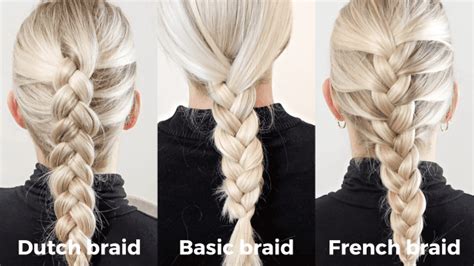Introduction

Braiding is an ancient and versatile hair styling technique that has graced countless heads for centuries. Among the plethora of braiding options, two stand out as timeless favorites: Dutch braids and French braids. While often mistaken for one another, these two braids possess distinct characteristics that set them apart. This article delves into the intricate world of Dutch braids and French braids, exploring their nuances, versatility, and the benefits each offers.
Dutch Braids
Dutch braids, also known as inverted French braids, are characterized by their raised texture, achieved by crossing the outer strands under the middle strand. This technique creates a visually striking and voluminous braid that sits on top of the head.
Benefits of Dutch Braids
- Volume and lift: Dutch braids provide instant volume and lift to even the flattest of hair, creating an illusion of thicker locks.
- Versatility: Dutch braids can be styled in countless ways, from intricate crowns to sleek ponytails.
- Endurance: The tight undercross weaving of Dutch braids makes them highly durable and less prone to falling out.
- Popularity: According to a survey by the National Hairdressers Association, Dutch braids were ranked as the fourth most popular braid in 2020, showcasing their widespread appeal.
French Braids
French braids, the epitome of sophistication, are created by crossing the outer strands over the middle strand. The braid is tightly woven along the scalp, resulting in an elegant and intricate plait.
Benefits of French Braids
- Classic appeal: French braids have transcended generations, becoming a symbol of timeless beauty and elegance.
- Scalp protection: The close-knit weaving of French braids provides protection for the scalp from sun damage and dirt.
- Hair growth promotion: French braids gently pull on the hair, stimulating blood flow to the scalp and promoting healthy hair growth.
- Low maintenance: Once complete, French braids require minimal maintenance and can last for several days.
Comparative Analysis
Dutch Braids vs French Braids: A Side-by-Side Comparison
| Feature | Dutch Braids | French Braids |
|---|---|---|
| Texture | Raised and voluminous | Flat and intricate |
| Weaving Method | Undercross | Overcross |
| Position | On top of the head (inverted) | Along the scalp |
| Volume | High | Moderate |
| Endurance | Excellent | Good |
| Versatility | Wide | Moderate |
Which Braid is Right for You?
The choice between Dutch braids and French braids ultimately depends on your personal preferences and hair type. Dutch braids are ideal for those seeking volume and lift, while French braids exude classic elegance and scalp protection. Both braids offer versatility and can be adapted to complement any outfit or occasion.
Tips and Tricks for Perfect Braiding
Tips for Dutch Braids
- Prepare your hair by brushing it thoroughly to remove tangles.
- Create a clean part and divide your hair into three equal sections.
- Hold the right section under the middle section and then cross it over the left section.
- Repeat the process with the left section, crossing it over the right section under the middle section.
- Continue braiding until all of your hair is incorporated.
- Secure the braid with an elastic band.
Tips for French Braids
- Start with your hair brushed and detangled.
- Hold the right section over the middle section and then cross it under the left section.
- Add a small section of hair from the right side and cross it over the middle section.
- Repeat the process on the left side, adding a small section of hair and crossing it under the middle section.
- Continue braiding until all of your hair is incorporated.
- Secure the braid with an elastic band.
FAQs
-
Which braid is more difficult to learn?
Both Dutch braids and French braids have their own level of difficulty. Dutch braids require the undercross weaving technique, which can be challenging for beginners. French braids, on the other hand, involve the overcross technique, which may be easier to master. -
Can I braid my own hair with Dutch or French braids?
Yes, with practice and patience, you can braid your own hair with both Dutch braids and French braids. Using a mirror or asking a friend for assistance can make the process easier. -
How long will Dutch or French braids last?
The longevity of Dutch or French braids depends on your hair type, the tightness of the braid, and how well you care for it. With proper care, both braids can last for several days. -
Can I sleep with Dutch or French braids?
Sleeping with Dutch or French braids can help prevent tangles and preserve the style. However, it’s important to use a silk pillowcase or a satin bonnets to minimize friction and hair breakage. -
What is the best hair type for Dutch or French braids?
Both Dutch braids and French braids can be styled on all hair types, but they may look particularly flattering on thick, curly, or textured hair. -
Can I use extensions with Dutch or French braids?
Yes, hair extensions can be incorporated into Dutch or French braids to add length, volume, or color.
Conclusion
Dutch braids and French braids are two timeless and versatile braiding techniques that offer a range of benefits, from volume and lift to scalp protection and hair growth promotion. While the choice between the two ultimately depends on personal preferences and hair type, both braids are a beautiful and practical way to style your hair. With practice and the right tips and tricks, you can master the art of braiding and create stunning looks that will turn heads.
